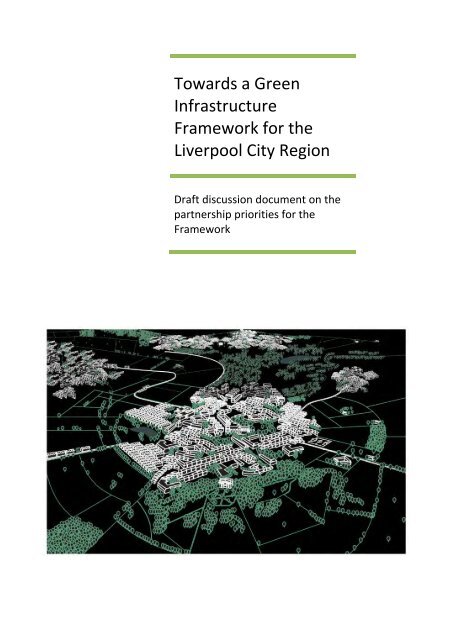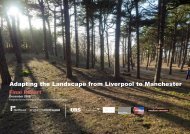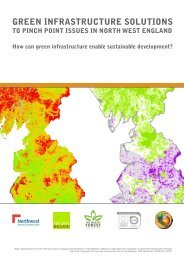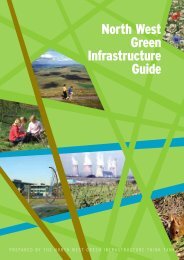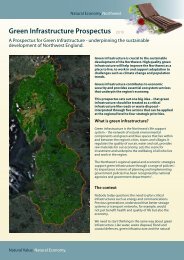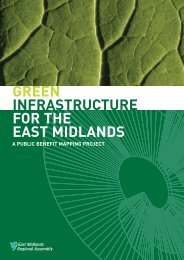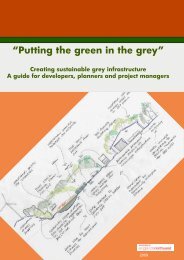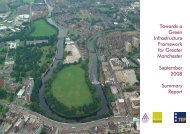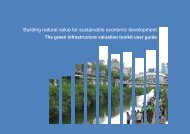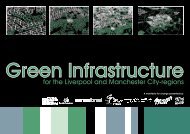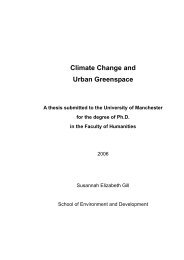Towards a Green Infrastructure Framework for the Liverpool City ...
Towards a Green Infrastructure Framework for the Liverpool City ...
Towards a Green Infrastructure Framework for the Liverpool City ...
- No tags were found...
Create successful ePaper yourself
Turn your PDF publications into a flip-book with our unique Google optimized e-Paper software.
At present we are still at Step 1, working to establish <strong>the</strong> partnership and agree <strong>the</strong> priorities <strong>for</strong><strong>the</strong> framework. In particular this discussion paper sets out <strong>the</strong> initial ideas <strong>for</strong> <strong>the</strong> priorities thatwill guide <strong>the</strong> framework.3.1. PARTNERSHIP AND PRIORITIESWork through 2008 focused on ga<strong>the</strong>ring in<strong>for</strong>mation securing mandate and support <strong>for</strong> a greeninfrastructure framework and starting to develop a partnership to take <strong>the</strong> work <strong>for</strong>ward, workthat needs to continue in order to get widespread support <strong>for</strong> this approach. The development ofa <strong>Green</strong> <strong>Infrastructure</strong> <strong>Framework</strong> is identified as a priority <strong>the</strong>me by <strong>the</strong> emerging Environmentand Waste Board.The partnership is evolving from <strong>the</strong> initial three meetings that were held to look at greeninfrastructure planning <strong>for</strong> <strong>the</strong> <strong>Liverpool</strong> <strong>City</strong> Region.3.2. ESTABLISHING PRIORITIESAs stated above, <strong>the</strong> priorities <strong>for</strong> <strong>the</strong> <strong>Liverpool</strong> <strong>City</strong> region green infrastructure framework needto be appropriate <strong>for</strong> this scale of planning. Having assessed a range of regional and sub regionaldocuments it is proposed (and to be discussed) that <strong>the</strong> following five areas should be <strong>the</strong>priorities <strong>for</strong> <strong>the</strong> green infrastructure framework:1. Setting <strong>the</strong> Scene <strong>for</strong> Growth - where can green infrastructure support economicdevelopment by providing attractive settings, increasing environmental quality andattracting/retaining people in <strong>the</strong> city region through excellent image and high quality oflife.2. Adapting to and mitigating climate change – where and how can green infrastructure helpto prepare <strong>the</strong> <strong>City</strong> Region <strong>for</strong> projected climate change and how can we safeguard <strong>the</strong>ecosystem services derived from <strong>the</strong> green infrastructure that underpin society.3. Providing access to high quality recreation – specifically looking at <strong>the</strong> provision ofstrategic routes and also <strong>the</strong> impacts of cumulative development in areas that cannotprovide <strong>the</strong> levels of open space required.4. Safeguarding and enhancing <strong>the</strong> ecological framework of <strong>the</strong> city region – how can greeninfrastructure planning (and in particular its influence on grey infrastructure plans) help tomaintain, restore, expand habitats and species populations and increase <strong>the</strong> movement ofwildlife between important biodiversity areas.5. Supporting <strong>the</strong> Rural Economy of <strong>the</strong> <strong>City</strong> Region - how will green infrastructure planninghelp to support <strong>the</strong> Rural Economy Action Plan, and in particular help to guidediversification, recognizing <strong>the</strong> importance of this sector in particular as it covers 50% of<strong>the</strong> land area and provides many of <strong>the</strong> green infrastructure benefits.
We recognise that <strong>the</strong>se five priorities identified <strong>for</strong> a <strong>Liverpool</strong> <strong>City</strong> Region <strong>Green</strong> <strong>Infrastructure</strong><strong>Framework</strong> cut across a wide range of policies and strategies and are <strong>the</strong>mselves interlinked. Thepurpose of green infrastructure planning will be to assess how multiple benefits can be securedand also how we can safeguard and enhance <strong>the</strong> functionality of <strong>the</strong> green infrastructure.For instance, areas of high quality recreation in rural areas will provide opportunities to connecthabitats, reduce travel (low carbon) to recreation areas fur<strong>the</strong>r afield, helping to provideadaptation benefits and help create a city region that is an attractive place in which to live andwork.4. TEST OF APPROPRIATE SCALE1In order to help to confirm that <strong>the</strong>se five priorities are appropriately planned <strong>for</strong> in greeninfrastructure terms at <strong>the</strong> sub regional scale we have asked <strong>the</strong> following questions about eachone:Could green infrastructure planning at this level support planning at a lower level?Could this green infrastructure planning be done at a higher level?
Is <strong>the</strong>re policy/strategy support <strong>for</strong> sub regional working on this issue?Does <strong>the</strong> issue cross administrative boundaries?Will it provide in<strong>for</strong>mation that would not o<strong>the</strong>rwise be available at <strong>the</strong> levels above andbelow?Table 1 overleaf provides a summary of <strong>the</strong> in<strong>for</strong>mation that we have ga<strong>the</strong>red.
QuestionSetting <strong>the</strong> Scene <strong>for</strong>GrowthClimate ChangePriorityRecreation, leisureand tourismEcologicalframeworkRural EconomyWill this provideevidence <strong>for</strong> greeninfrastructureplanning at a localauthority level?Yes - on key routesthat provide improvedimage around keyinvestment andplanned growth areas.Yes - to support localclimate change andflood managementplans.Yes – on key strategicroutes.Yes – on keyelements of anecological framework.Yes - on range of sectorscomprising <strong>the</strong> ruraleconomy, and are dispersedacross <strong>the</strong> sub region.Could this work bedone at a higherlevel?Yes - but <strong>the</strong> level ofdetail/ types of actionsmay not be specificenough at a regionallevel.Possibly - butin<strong>for</strong>mation will bemore generic and notlinked to specificareas of greeninfrastructure.Possibly.Possibly - but detailwould be moregeneric and lessuseful as an evidencebase <strong>for</strong> local plans,etc.No - Merseyside has aspecific "signature" <strong>for</strong> itsrural economy and needs aspecific sub regional plan.Policy/Strategicsupport <strong>for</strong> work atthis level?Yes - <strong>City</strong> RegionPlanning, SREconomic Strategy,MAAYes - <strong>City</strong> RegionBoard have overviewof this. Mini Sternreport to be issued <strong>for</strong><strong>the</strong> area soon.Health is Wealth.Feedback hasindicated that LDFsneed to look at subregional strategicroutes, sites, etc.North MerseysideBAP. RSS PolicyEM1b. Merseyside EFRural Economy Action Planbeing developed at <strong>the</strong>moment.Is this a crossboundary issue?Yes Yes Yes Yes YesIs <strong>the</strong>re linkage with<strong>the</strong> o<strong>the</strong>r policyboardsYes - Economy;Employment andSkills: Planning andHousing; Safer,Healthier CommunitiesYes - Planning andHousing; Safer,HealthierCommunitiesYes - Economy;Employment & Skills;Planning & Housing;Safer, HealthierCommunitiesYes - Planning andHousing;Yes - Economy;Employment and Skills:Planning and Housing;Will it providein<strong>for</strong>mation that wouldnot o<strong>the</strong>rwise beavailable at <strong>the</strong> levelsabove and below?Yes - more detail thanlevel above, crossboundary issues <strong>for</strong>levels belowYes - detail that canprovide greeninfrastructurefunctionality outsideof <strong>the</strong> individuallocal authority areas.Possibly Yes Yes
5. DISCUSSION ON THE FIVE PRIORITIESThese five priorities cut across a wide range of policies and strategies and are <strong>the</strong>m selvesinterlinked. The purpose of green infrastructure planning will be to assess how multiple benefitscan be secured and also how we can safeguard and enhance <strong>the</strong> functionality of <strong>the</strong> greeninfrastructure.5.1. SETTING THE SCENE FOR GROWTH<strong>Green</strong> infrastructure planning can help to deliver benefits that directly contribute to <strong>the</strong> deliveryof improved environmental quality. Important areas to assess <strong>for</strong> <strong>the</strong> framework will be:Key transport routes – road, rail, waterStrategic investment sites – where it is anticipated that investment will take placeThe landscape area between <strong>Liverpool</strong> and ManchesterThe development of <strong>the</strong> city region economy can be supported by <strong>the</strong> development of high qualitygreen infrastructure to help to attract both new investment and <strong>the</strong> range of high calibre workers.There is a great deal of evidence available to support green infrastructure benefits <strong>for</strong> <strong>the</strong>economy:Policy support <strong>for</strong> this priority (though not explicit) comes from; Sub regional economic strategy –“Merseyside must strive to develop a positive relationship between <strong>the</strong> often conflicting goals ofreducing impact on <strong>the</strong> environment and continued economic growth, as well as developingopportunities presented by sector specialisms in waste management, environmental technologiesand green infrastructure.”
Multi Area Agreement –Worklessness and Skills – MAA Employment and Skills plat<strong>for</strong>m outcomes.Increasing Jobs – MAA Economy Plat<strong>for</strong>mImproving HealthRunning our Businesses EfficientlyCross boundary work is essential if <strong>the</strong> opportunities <strong>for</strong> improving environmental quality are tobe fully realised. Key gateways and strategic investment areas may not always be <strong>the</strong> same localauthority and <strong>the</strong> ability to look strategically cross boundaries can help to provide <strong>the</strong> setting <strong>for</strong>investment.The recently published work “<strong>Green</strong> <strong>Infrastructure</strong> Solutions to Pinch Point Issues in <strong>the</strong> NorthWest” will help in identifying both <strong>the</strong> key areas <strong>for</strong> this <strong>the</strong>me and also <strong>the</strong> types of greeninfrastructure issues that will impact on <strong>the</strong>se areas.
Pinch Sub-regional activity Lead body Existing activity thatcould assist in deliveryRisk of floodingAssess green infrastructure assetsand <strong>the</strong> need to manage and createnew green infrastructure to reducerisk of flood. Focus on creatinggrey/green infrastructure plans.Natural England, localauthorities, ForestryCommission, United Utilitiesand <strong>the</strong> EnvironmentAgency.Surface watermanagement plans;strategic flood riskplans; catchment areamanagement plans,Merseyside <strong>Green</strong><strong>Infrastructure</strong> PlanRisk of urban heatisland effectAssess areas of greatest impact,based on likely future developmentand presence of vulnerablecommunitiesLocal authorities, link to LAA188 - Adaptation to ClimateChangeClimate changestrategiesMerseyside <strong>Green</strong><strong>Infrastructure</strong> PlanRisk of loss ofbiodiversityEnsure robust protection in place<strong>for</strong> protected species in and aroundpinch points. Use greeninfrastructure planning to identifyopportunities to safeguard andenhance biodiversity around newinvestment.Natural England, ForestryCommission, <strong>the</strong>Environment Agency,Biodiversity Action PlanPartnershipsSub-regional BAPRisk of loss ofcarbon storageEnsure robust protection <strong>for</strong> storesof carbon and effective policy inplace to mitigate any loss of storeNatural England, localauthoritiesMerseyside SR <strong>Green</strong><strong>Infrastructure</strong> PlanRisk of poor airqualityAssess how in addition to measuresto reduce emission of pollutants, GIcan play a role in fur<strong>the</strong>r improvingair quality around specific areas ofpoor quality through, <strong>for</strong> example,woodland planting close tomotorway interchangesHighways Agency, <strong>the</strong>Environment Agency, localauthorities, ForestryCommissionAir quality plans,Merseyside <strong>Green</strong><strong>Infrastructure</strong> Plan
Risk of coastalstormsAssess key green infrastructureassets and <strong>the</strong> need to manage andcreate new green infrastructure toreduce risk of flood from coastalstorms. Focus on creatinggrey/green infrastructure plans. Inparticular look at <strong>the</strong> areas ofinterface between coastal stormflood and fluvial flood.Defra, <strong>the</strong> EnvironmentAgency, local authorities,NW Coastal ForumIntegrated coastalmanagement plans, NWcoastal strategy,Shoreline managementplansCurrent work looking at “Adapting <strong>the</strong> Landscape” across <strong>the</strong> Mersey Belt will also assist in guiding<strong>the</strong> development of a green infrastructure framework to areas of regeneration need andinvestment priority.Figure 1 Map Courtesy of NWDA Adapting <strong>the</strong> landscape study – Regeneration prioritiesFor example, <strong>the</strong> Growth Point has identified St.Helens Forest Park as a key element of <strong>the</strong> greeninfrastructure to support <strong>the</strong> environmental quality <strong>for</strong> <strong>the</strong> new housing areas in Halton, St.Helensand Warrington – but <strong>the</strong> <strong>for</strong>est park is entirely within St.Helens. Joined-up planning can maximise<strong>the</strong> benefits of <strong>the</strong> <strong>for</strong>est park area by providing cross boundary linkages and environmentalimprovements that extend <strong>the</strong> influence of <strong>the</strong> <strong>for</strong>est park wherever possible.
5.2. ADAPTING TO AND MITIGATING CLIMATE CHANGE –Climate change has been described as <strong>the</strong> greatest risk facing our society today. <strong>Green</strong>infrastructure has a role to play in both delivering adaptation and mitigation benefits.Key issues to address includeThe role of green infrastructure in helping to reduce flood risk and impactDeveloping a low carbon economyDoes not GI have a role to play in biomass production and decentralized renewable energygeneration?Co-ordinated approach to reducing urban heat island effectsThe latest UKCP 09 indicate that <strong>the</strong> city region will undergo climate change that will meanWarmer wetter wintersHotter drier summersMore intense, sporadic wea<strong>the</strong>r conditionsThe Mini Stern report has indicated that climate change will have a major impact on <strong>the</strong> economyof <strong>the</strong> city region.
However, whilst <strong>the</strong> report has not covered issues related to climate change adaptation, <strong>the</strong>evidence that green infrastructure can play a role in mitigating and adapting to climate change iswide ranging.Support <strong>for</strong> this activity comes from both <strong>the</strong> remit of <strong>the</strong> <strong>City</strong> Region and <strong>the</strong> sub regionaleconomic plan priority to deliver a low carbon economy.Work is currently underway to develop a regional green infrastructure and adaptation to climatechange plan. This will be published in June 2010 and will help to identify some of <strong>the</strong> key actionsthat need to be taken <strong>for</strong>ward by sub regional and local plans. The study “Critical <strong>Green</strong><strong>Infrastructure</strong> and Climate Change” produced last year as part of <strong>the</strong> North West Climate ChangeAction Plan, will also help to identify key issues in <strong>the</strong> <strong>Liverpool</strong> <strong>City</strong> Region.There are also a number of research and action research programmes such as ForeStClim that willhelp to in<strong>for</strong>m <strong>the</strong> development of this <strong>the</strong>me within <strong>the</strong> <strong>Framework</strong>.As many of <strong>the</strong> issues associated with <strong>the</strong> risks and impacts of climate change are cross boundary,effective identification of actions that can take place at a sub regional level can help in <strong>the</strong> ongoingdevelopment and subsequent delivery of local climate change action plans.
5.3. PROVIDING ACCESS TO HIGH QUALITY RECREATION, LEISURE ANDTOURISM FACILITIESAt a city region level this will specifically look at <strong>the</strong> improvement in provision of strategic routesand sites, and also <strong>the</strong> impacts of cumulative development in areas that cannot provide <strong>the</strong> levelsof open space required. These areas may need to look cross-boundary in order to satisfy <strong>the</strong> need<strong>for</strong> high quality recreation and leisure.There are a number of standards <strong>for</strong> provision of open space (ANGST) and woodland (WoodlandTrust - Woods <strong>for</strong> People) that can be used to assess existing provision. However <strong>the</strong>se standardsneed to be looked at a sub-regional level and <strong>for</strong> those areas close to <strong>the</strong> city region boundary willalso need to look across <strong>the</strong> boundary into <strong>the</strong> Cheshire, Lancashire and Manchester areas.High quality recreation is a key aspect of <strong>the</strong> quality of life potential provided by an area. Evidenceshows that this can play a key role in attracting investment and also in retaining individuals withhigh skill and qualification levels. We can also identify a hierarchy of sites (ref to be added)One key area <strong>for</strong> recreation will be <strong>the</strong> coast of <strong>the</strong> <strong>City</strong> Region. Research by University ofManchester has identified <strong>the</strong> coast as being a key resource <strong>for</strong> recreation as <strong>the</strong> climate changes.This will require careful management of an already well used resource.5.4. SAFEGUARDING AND ENHANCING THE ECOLOGICAL FRAMEWORK OFTHE CITY REGIONAn ecological framework is a major component of a green infrastructure plan. The frameworkidentifies <strong>the</strong> key areas to safeguard and enhance and should identify <strong>the</strong> opportunities that existto extend and link sites so as to provide, in particular, ecological benefits.At present an ecological framework is being developed <strong>for</strong> <strong>the</strong> <strong>City</strong> Region, led by Merseyside EAS(a draft map of resources is currently under consultation). The partnership developing <strong>the</strong> greeninfrastructure framework will be involved in this work and have already assisted by providingsome of <strong>the</strong> funding <strong>for</strong> <strong>the</strong> ecological framework.Through green infrastructure planning we hope to be able to help to deliver elements of <strong>the</strong>ecological framework, but also extend <strong>the</strong> opportunities <strong>for</strong> <strong>the</strong> benefits of high quality habitatinto areas that perhaps are not yet in <strong>the</strong> ecological framework, but can provide valuablebiodiversity benefits. Integrating <strong>the</strong> ecological framework with emerging strategies andprogrammes <strong>for</strong> regeneration and <strong>the</strong> land use planning system will be essential to safeguard andenhance <strong>the</strong> contribution that <strong>the</strong> ecological framework can make to <strong>the</strong> <strong>Liverpool</strong> <strong>City</strong> Region.
Through green infrastructure interventions it is important to enhance our existing wildlifestrengths and bring more of our wildlife sites into active management, with multiple functionswhere appropriate.5.5. SUPPORTING THE RURAL ECONOMY OF THE CITY REGIONOne of <strong>the</strong> 11 benefits that have been identified as being delivered by green infrastructure is“Products from <strong>the</strong> Land”. However it is often a benefit that is overlooked or not considered <strong>for</strong>green infrastructure planning. The rural economy, much of it dependent on <strong>the</strong> land, provides 25%of <strong>the</strong> GVA <strong>for</strong> <strong>the</strong> <strong>City</strong> Region. 50% of <strong>the</strong> <strong>City</strong> Region area is rural.Figure 2 Courtesy of REAPAs can be seen from Map 1 (from current REAP study) <strong>the</strong> rural areas wrap around <strong>the</strong> towns andcities in <strong>the</strong> <strong>City</strong> Region.The impacts of farm practices and land management cross boundaries and <strong>the</strong> current MerseysideRural Economy Action Plan (REAP) work will help to identify a range of issues some of which weshould capture in a <strong>City</strong> Region green infrastructure plan. Ano<strong>the</strong>r key driver <strong>for</strong> this work will be<strong>the</strong> RDPE programme, Merseyside Rural Leader that is providing support <strong>for</strong> this sector.
APPENDIXThe concept of green infrastructure was originally developed in <strong>the</strong> United States, but is increasingly beingadopted and adapted <strong>for</strong> use in a UK context.<strong>Green</strong> infrastructure has been defined as “<strong>the</strong> region's life support system – <strong>the</strong> network of naturalenvironmental components and green and blue spaces that lies within and between <strong>the</strong> North West'scities, towns and villages which provides multiple social, economic and environmental benefits” 1 . TheNatural Economy North West (NENW) project has identified eleven interlinked economic benefits 2 providedby green infrastructure:Figure 3 The eleven benefits of green infrastructure taken from NENW report 3In <strong>the</strong> NW Principles and Issues paper 4 green infrastructure is included as an issue <strong>for</strong> <strong>the</strong> sustainabledevelopment of <strong>the</strong> region:“A regionally distinctive natural and marine environment which has rich biodiversity”and “good quality green infrastructure and pubic open space/parks accessible to all.”An increasing range of polices and strategies are incorporating green infrastructure. Appendix 1 provides anexhaustive list of <strong>the</strong> current state of policy and strategy in relation to green infrastructure (courtesy of1 North West <strong>Green</strong> <strong>Infrastructure</strong> Guide (version 1.1). Prepared by <strong>the</strong> North West <strong>Green</strong> <strong>Infrastructure</strong> Think Tank.www.greeninfrastructurenw.co.uk2 Whilst <strong>the</strong> list states ‘economic benefits’, it arguably covers <strong>the</strong> social and environmental benefits as well.3 The Economic Benefits of <strong>Green</strong> <strong>Infrastructure</strong>, The Mersey Forest on behalf of NENW, 20084 RS 2010 Regional Strategy <strong>for</strong> England’s North West, Principles and Issues paper, NWDA, 2009
Helen Sweeney, GONW). From this assessment we can see that <strong>the</strong>re is also an emerging policy framework<strong>for</strong> GI in <strong>the</strong> <strong>City</strong> Region.<strong>Green</strong> infrastructure planning in <strong>the</strong> UK builds on <strong>the</strong> legacy of ideas and initiatives going back over 150years (<strong>City</strong> Parks, Garden Cities, <strong>Green</strong> Belt, Community Forest (The Mersey Forest in this area) etc.) 5 , but itdiffers from many conventional land conservation and natural resource protection approaches because itlooks at bringing land development, man-made infrastructure planning and <strong>the</strong> natural environmenttoge<strong>the</strong>r 6 . <strong>Green</strong> infrastructure planning seeks to optimise land use to meets <strong>the</strong> needs of people andnature.<strong>Green</strong> infrastructure needs to be planned and managed in <strong>the</strong> same manner as o<strong>the</strong>r types ofinfrastructure that underpin society.“For green infrastructure to be truly of value it requires co-ordination and co-operationacross political and administrative boundaries. It must be strategically planned,invested in and managed on scales ranging from <strong>the</strong> local to <strong>the</strong> regional, and insettings from urban centres to <strong>the</strong> open countryside. In short, green infrastructureneeds to be planned, developed and managed just like all o<strong>the</strong>r <strong>for</strong>ms ofinfrastructure, if society is to thrive and prosper.”Hazel Blears - Sept 2008<strong>Green</strong> infrastructure planning is also based on eight principles: Identify and protect green infrastructure be<strong>for</strong>e development Engage diverse people and organisations from a range of sectors Linkage is key: connect green infrastructure components with each o<strong>the</strong>r and with people Design green infrastructure systems that function at different scales and across boundaries <strong>Green</strong> infrastructure activity must be grounded in good science and planning practice Fund green infrastructure up-front as a primary public investment Emphasise green infrastructure benefits are af<strong>for</strong>ded to all: to nature and people <strong>Green</strong> infrastructure should be <strong>the</strong> framework <strong>for</strong> conservation.Using existing frameworksThe <strong>Liverpool</strong> <strong>City</strong> Region <strong>Green</strong> <strong>Infrastructure</strong> <strong>Framework</strong> has been developed using a methodology setout in NW GI Guide, <strong>the</strong> document that supports policy EM3 - <strong>Green</strong> <strong>Infrastructure</strong>, in <strong>the</strong> Regional SpatialStrategy. The framework also is guided by <strong>the</strong> guidance produced through <strong>the</strong> Natural Economy NWprogramme and <strong>Green</strong> <strong>Infrastructure</strong> Unit on GI planning at a sub regional scale and detailed GI planningmethodology.In particular this framework helps to deliver three (Change) key actions from <strong>the</strong> NENW study “Developingan outline strategy <strong>for</strong> linking green and grey infrastructure” 75 See also presentation by Ian Wray, Head of Planning NWDA, 4 th December 2008, www.greeninfrastructurenw.org.uk6 <strong>Green</strong> <strong>Infrastructure</strong>, Benedict and McMahon. 2006. Island Press ISBN1-55963-558-47 Developing an outline strategy <strong>for</strong> linking green and grey infrastructure, NENW, 2008
Table 3Increasingly green infrastructure planning is becoming integrated with <strong>the</strong> ecosystem services approach 8 ,<strong>for</strong> example through joint work with SWIMMER at <strong>the</strong> University of <strong>Liverpool</strong> 9 on a project at Alder Hey,and through <strong>the</strong> trans-regional work looking at practical methodologies <strong>for</strong> valuing green infrastructure. 10It is particularly important to highlight that this study does not set out a green infrastructure strategy <strong>for</strong><strong>the</strong> region. The remit of <strong>the</strong> study is focused on specific areas where it is anticipated that investment will bemade or a key economic driver needs to be safeguarded from a set of particular issues (pinches) and<strong>the</strong>re<strong>for</strong>e is limited in its scope. The sub-regional green infrastructure frameworks and strategies will beimportant in identifying <strong>the</strong> functionality of and need <strong>for</strong> green infrastructure <strong>for</strong> future development. It isessential that <strong>the</strong>re is continued communication between this work and <strong>the</strong> emerging green infrastructureplans.8 For example see www.millenniumassessment.org/en/index.aspx9 www.liv.ac.uk/swimmer/research/research_projects/index.htm10 Practical ways of valuing <strong>Green</strong> <strong>Infrastructure</strong> and raising awareness of its strategic importance, Genecon, 2009 (work underway)


